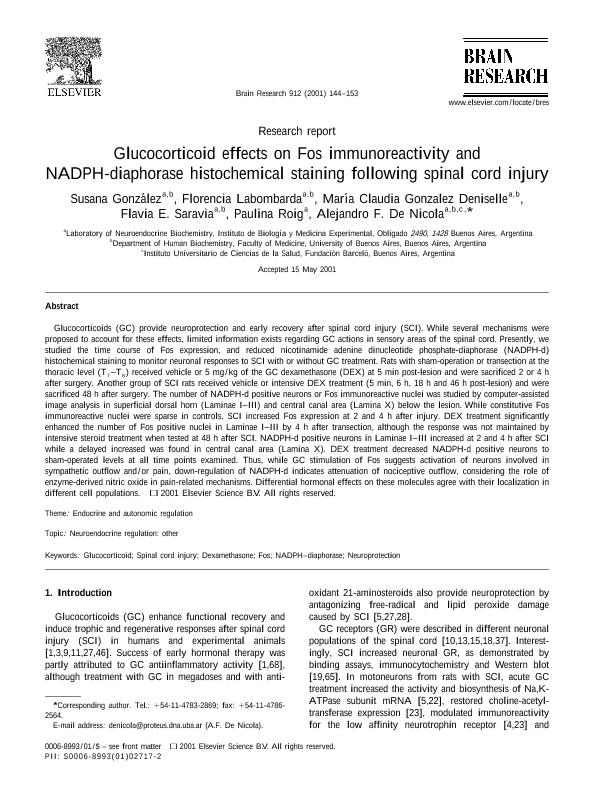Artículo
Glucocorticoid effects on Fos immunoreactivity and NADPH-diaphorase histochemical staining following spinal cord injury
Gonzalez, Susana Laura ; Labombarda, Maria Florencia
; Labombarda, Maria Florencia ; Gonzalez Deniselle, Maria Claudia
; Gonzalez Deniselle, Maria Claudia ; Saravia, Flavia Eugenia
; Saravia, Flavia Eugenia ; Roig, Paulina
; Roig, Paulina ; de Nicola, Alejandro Federico
; de Nicola, Alejandro Federico
 ; Labombarda, Maria Florencia
; Labombarda, Maria Florencia ; Gonzalez Deniselle, Maria Claudia
; Gonzalez Deniselle, Maria Claudia ; Saravia, Flavia Eugenia
; Saravia, Flavia Eugenia ; Roig, Paulina
; Roig, Paulina ; de Nicola, Alejandro Federico
; de Nicola, Alejandro Federico
Fecha de publicación:
06/2001
Editorial:
Elsevier Science
Revista:
Brain Research
ISSN:
0006-8993
Idioma:
Inglés
Tipo de recurso:
Artículo publicado
Clasificación temática:
Resumen
Glucocorticoids (GC) provide neuroprotection and early recovery after spinal cord injury (SCI). While several mechanisms were proposed to account for these effects, limited information exists regarding GC actions in sensory areas of the spinal cord. Presently, we studied the time course of Fos expression, and reduced nicotinamide adenine dinucleotide phosphate-diaphorase (NADPH-d) histochemical staining to monitor neuronal responses to SCI with or without GC treatment. Rats with sham-operation or transection at the thoracic level (T7-T8) received vehicle or 5 mg/kg of the GC dexamethasone (DEX) at 5 min post-lesion and were sacrificed 2 or 4 h after surgery. Another group of SCI rats received vehicle or intensive DEX treatment (5 min, 6 h, 18 h and 46 h post-lesion) and were sacrificed 48 h after surgery. The number of NADPH-d positive neurons or Fos immunoreactive nuclei was studied by computer-assisted image analysis in superficial dorsal horn (Laminae I-III) and central canal area (Lamina X) below the lesion. While constitutive Fos immunoreactive nuclei were sparse in controls, SCI increased Fos expression at 2 and 4 h after injury. DEX treatment significantly enhanced the number of Fos positive nuclei in Laminae I-III by 4 h after transection, although the response was not maintained by intensive steroid treatment when tested at 48 h after SCI. NADPH-d positive neurons in Laminae I-III increased at 2 and 4 h after SCI while a delayed increased was found in central canal area (Lamina X). DEX treatment decreased NADPH-d positive neurons to sham-operated levels at all time points examined. Thus, while GC stimulation of Fos suggests activation of neurons involved in sympathetic outflow and/or pain, down-regulation of NADPH-d indicates attenuation of nociceptive outflow, considering the role of enzyme-derived nitric oxide in pain-related mechanisms. Differential hormonal effects on these molecules agree with their localization in different cell populations.
Palabras clave:
Nadphd
,
Fos
,
Dexa
,
Motoneuron
Archivos asociados
Licencia
Identificadores
Colecciones
Articulos(IBYME)
Articulos de INST.DE BIOLOGIA Y MEDICINA EXPERIMENTAL (I)
Articulos de INST.DE BIOLOGIA Y MEDICINA EXPERIMENTAL (I)
Citación
Gonzalez, Susana Laura; Labombarda, Maria Florencia; Gonzalez Deniselle, Maria Claudia; Saravia, Flavia Eugenia; Roig, Paulina; et al.; Glucocorticoid effects on Fos immunoreactivity and NADPH-diaphorase histochemical staining following spinal cord injury; Elsevier Science; Brain Research; 912; 2; 6-2001; 144-153
Compartir
Altmétricas



